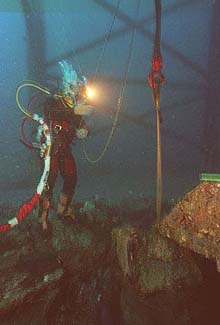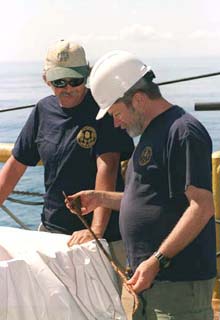
A Navy diver walks across the Monitor's hull as he rigs the engine for lifting. U.S. Navy photo by PH2 E. Lippman. Click image for larger view.

Expedition Chief Scientist John Broadwater (right) and Expedition Historian Jeff Johnston examine a lubrication cup from one of the Monitor's ventilation blower engines. U.S. Navy photo by PHC A. McKaskle. Click image for larger view.
Monitor 2001 - Phase II
Progress Report
June 30, 2001
John Broadwater, Manager
Monitor National Marine Sanctuary
Jeffrey Johnston, Historian
Monitor National Marine Sanctuary
Work is going well. The Wotan barge arrived at the Monitor National Marine Sanctuary on Sunday, June 17. We anchored over the Monitor before noon, and began diving almost immediately. The expedition made U.S. Navy history when the first Navy "saturation" diver exited the Global Marine commercial diving bell and worked with two other Navy divers using standard "surface-supplied" equipment. Saturation diving is routinely used in the commercial diving world, especially in oil fields, but the Navy does not use it extensively, and had never before used a non-Navy system. Read more about saturation diving.
Even though the Wotan’s deck is the size of a football field, space is a problem. We're now at our full maximum complement of 108 divers, engineers, archaeologists, and support personnel. The barge has facilities for only 65 people; however, the Navy needs all the divers it can muster aboard to operate two dive systems 24 hrs per day, 7 days per week. Therefore, additional housing "modules" were set up, and extra galley hands brought aboard. We have filled the deck with two dive systems, a remotely operated vehicle (ROV) system, pumps, generators and other diving equipment, and huge cylinders of gas for the divers to breathe. Not to mention the 500- and 100-ton cranes!
The weather has been generally good, and we’ve made progress. We've finished surveying the engine, removed a series of hull plates, and attached four primary supporting slings from the engine to the engine lifting frame. We've recovered some interesting artifacts, which will be transported to The Mariners’ Museum in Newport News, VA. We have several iron keel and hull plates, over 50 ft of copper steam piping, a 450-lb hull fitting, pressure valves, tool handles, brass lantern parts, and a dozen or so glass lantern chimneys. We (see photo, left) are each covering a 12-hr shift, from 6 am to 6pm and vice versa. During each shift, one of us has to observe three to five surface-supplied dives and two four-hr saturation dives, which keeps us on the move. We also document progress, observe the ROV work, participate in dive briefings, discuss plan modifications (based on work accomplished and new finds), and keep up with artifact documentation and on-site artifact storage. Because of the pace of activity, our work almost inevitably continues into the next shift, and a typical work day is 16-20 hrs! It's tiring, but very exciting.
Work is now focused on removing the engine’s steam condenser, which weighs an estimated 6,000 lbs, excavating the silt and debris that covers almost half the engine, and continuing to rig the engine for recovery.
Sign up for the Ocean Explorer E-mail Update List.






















